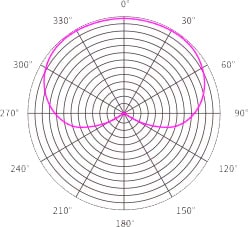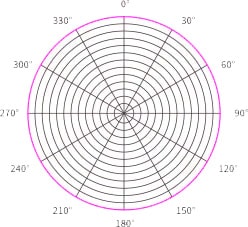Introduction
Microphones are essential tools in the recording studio, capturing everything from the subtle nuances of a vocal performance to the complex textures of instruments. A crucial aspect of microphone technology that impacts recording quality and versatility is the polar pattern. The polar pattern of a microphone determines how it picks up sound from different directions. This article will explore the primary microphone patterns used in studio recording: cardioid, omnidirectional, figure-8 (bidirectional), and the variations within these categories.
Cardioid Microphones

Cardioid microphones are named for their heart-shaped pattern of sound sensitivity. They are designed to capture sound from the front and sides while rejecting sound from the rear. This makes them exceptionally useful in isolating a sound source from unwanted background noise. Cardioid microphones are versatile and commonly used for vocals, as well as for miking individual instruments in a live or studio setting.
Subtypes of Cardioid Microphones
- Hypercardioid: Offers a tighter front pickup angle and more rejection from the sides compared to standard cardioid mics. This pattern is beneficial in live sound environments to reduce feedback and isolate sound sources even further.
- Supercardioid: Lies between cardioid and hypercardioid patterns in terms of directionality and side-rejection capabilities. It provides a balance between focusing on the sound source and minimizing off-axis sound.The Art of Mastering
Omnidirectional Microphones

Omnidirectional microphones capture sound equally from all directions. This characteristic makes them ideal for recording ambient sounds or capturing the atmosphere of a room. They are often used in situations where the sound source’s directionality is less critical, or a natural sound is desired without the coloration and isolation provided by directional microphones.
Figure-8 Microphones

Figure-8 or bidirectional microphones pick up sound from both the front and back while rejecting sound from the sides. This pattern is particularly useful in stereo recording techniques such as mid-side (MS) recording, where one microphone captures the center image, and a figure-8 mic captures the side information. Figure-8 microphones are also favored for recording two sources simultaneously, like a duet, where two vocalists or instruments are positioned on either side of the microphone.
Multi-Pattern Microphones
Some microphones offer multiple polar patterns selectable either via a switch on the microphone itself or through software if the microphone is digital. These multi-pattern microphones are highly versatile, allowing engineers and producers to choose the most appropriate pattern for each recording situation. They can switch from omni for a roomy drum sound, to cardioid for a tight vocal take, to figure-8 for a ribbon mic on a guitar cab, all with the same microphone.
Choosing the Right Microphone Pattern
The choice of microphone pattern depends on various factors, including the sound source, the desired sound, the acoustics of the recording environment, and the presence of background noise. For instance, a cardioid microphone may be perfect for a vocal track to minimize room reflections and isolate the singer, while an omnidirectional mic might be the best choice for capturing a choir or ensemble, providing a natural blend of the performers with the room’s acoustics.
Following a few Practical Applications of Different Microphone Patterns: Everyday Studio Examples:
Cardioid Microphones
Vocal Recording
- Solo Vocal Performance: A cardioid microphone is often the first choice for recording solo vocal tracks. Its ability to focus on the sound coming directly from the singer while minimizing room noise and reflections ensures that the vocal performance is captured clearly and cleanly.
Drum Overheads
- Drum Kit Overheads: While omnidirectional or even matched pair microphones are commonly used for overheads, cardioid mics can also be effective in this role, particularly in a treated studio environment where the goal is to capture the cymbals and the overall kit without too much room sound.
Acoustic Instruments
- Acoustic Guitar Recording: A cardioid microphone positioned near the 12th fret of an acoustic guitar can capture a balanced mix of the string attack and the body resonance, providing a detailed and nuanced recording of the instrument.
Omnidirectional Microphones
Ambient Room Recording
- Capturing Room Ambience: Omnidirectional microphones are ideal for recording the natural ambience of a space, whether it’s capturing the sound of a room for a drum kit to sit in naturally within a mix or recording environmental sounds for post-production work.
Conference and Round Table Discussions
- Group Vocal Applications: In scenarios where multiple people are speaking, such as in a podcast or a round-table discussion, an omnidirectional microphone placed centrally can evenly capture all participants’ voices without favoring one direction.
Ensemble Recordings
- Choirs and Orchestras: For recording large ensembles or choirs in a space with good acoustics, omnidirectional microphones can capture the blend and balance of the group along with the natural reverb of the room, providing a true-to-life auditory experience.
Figure-8 Microphones
Duets and Interviews
- Two-Person Podcasts or Interviews: By positioning the interviewee and interviewer on opposite sides of a figure-8 microphone, you can capture both voices clearly while maintaining a comfortable, face-to-face conversation setup.
Mid-Side Recording Technique
- Stereo Recording: In the mid-side (MS) recording technique, a figure-8 microphone is used in conjunction with a cardioid mic. The figure-8 captures the side information (left and right differences), while the cardioid captures the mid (center) information. This technique is versatile in post-production, allowing for adjustable stereo width.
Blumlein Pair Technique
- Stereo Room or Instrument Miking: The Blumlein Pair technique involves two figure-8 microphones positioned at 90 degrees to each other. This setup is excellent for capturing a realistic stereo image of acoustic performances, ensembles, or room ambiances, providing a natural sense of space and directionality.
Each of these examples demonstrates how the choice of microphone pattern can significantly impact the outcome of a recording, underlining the importance of understanding and utilizing different microphone patterns to achieve the desired audio quality and character in various recording scenarios.
Conclusion
Understanding microphone polar patterns is fundamental for anyone involved in recording music. By selecting the appropriate microphone pattern for a given situation, recording engineers can greatly influence the quality and character of the recorded sound. Whether it’s the focused isolation of a cardioid pattern, the open and natural sound of an omnidirectional mic, or the unique capabilities of a figure-8 microphone, the choice of pattern can make all the difference in achieving the desired recording outcome.
Conclusion
While mixing and mastering are distinct processes, they are interdependent. A well-mixed song makes the mastering process more effective and vice versa. Understanding these differences is crucial for anyone looking to produce professional-quality music.
